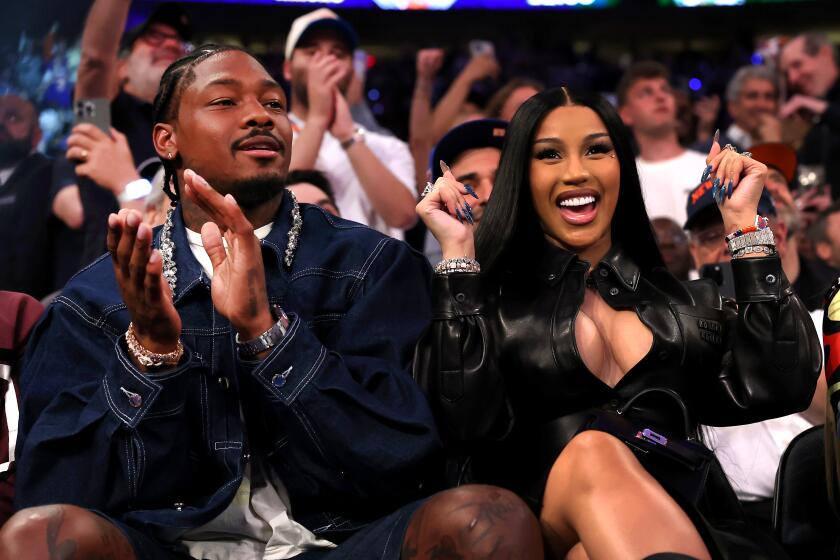M.C. Hammer Has a Baseball Background
- Share via
For those unconvinced that the Oakland Athletics are a team that has everything, there is the matter of Stanley Burrell. As if it weren’t enough that the defending world champions boast a starting rotation with two 20-game winners, a superb bullpen, twin towers of power, a man on the verge of a record for career stolen bases and a spare outfielder who clinched the National League batting title while observing an American League game, herewith the Hammer. Or M.C. Hammer, as he now bills himself.
To the DH, a position where they are at least three-deep entering the American League Championship Series Saturday night against the Boston Red Sox, the A’s have added the DR, as in designated rapper. Fittingly, Oakland’s gift to the latest phenomenon in music has sterling credentials. The man’s second album, “Please Hammer Don’t Hurt ‘Em,” has surpassed five million in sales. Not only does that make it the best-selling album of any kind this year but the best-selling rap album of all time.
Much like Spike Lee in his trademark Brooklyn cap and Dodgers shirt, Hammer frequently wears his hometown affiliation on his sleeve. But this is not a case of a celebrity fan identifying with a time and place, such as Tom Selleck in his Detroit Tigers cap. Burrell, aka Hammer, once served as an executive with the A’s, if in name only. The first stage on which he performed was in Oakland-Alameda County Coliseum.
That’s where Burrell, “discovered” by former owner Charles O. Finley while dancing for his supper in the parking lot, first assumed his alter ego. Given a job in the clubhouse, the youngster soon received a nickname from the players who had recently reveled in a third consecutive World Series triumph but would win no more in the Finley era. He became the Little Hammer, for his facial resemblance to Henry Aaron.
With promotions from Finley and his own gift for self-promotion, Burrell was on his way to the top. From batboy to office boy to errand boy and, finally, to executive vice president. To appreciate the joke, however, it is necessary to understand the condition of the A’s franchise at the time.
As the team sank in the standings, the visits by Finley -- an absentee owner who continued to run a Chicago-based insurance company -- were less frequent. The front-office staff evolved into a skeleton crew, invested with the authority to answer the telephone and do little else. The A’s idea of advertising the product was the distribution of schedules each spring. Its broadcasting lineup became an annual guessing game, and one year the radio rights were acquired for the asking by the college station at the University of California, Berkeley.
In such an atmosphere, Burrell ascended to the owner’s box. “He used to sit up there during games and call Charlie with the play-by-play,” recalled Mickey Morabito, whom freshly installed Manager Billy Martin brought to Oakland as public relations director and traveling secretary in 1980 in the last year of Finley’s reign. My first sight of him was in 1978 during a rare visit to what was then known as the Mausoleum for its lack of warmth and live bodies. The A’s were en route to an attendance figure of 526,999. That was one year before they bottomed out at 306,763.
On this particular day, the debut performance of top draft choice Mike Morgan one week after his high school graduation, Burrell was on duty outside the club offices. The Hammer was 16 and semi-conspicuous. On the crown of his green-and-gold baseball cap, in large block letters, was his title: “VP.” For those who might not have gotten the message, he greeted the elevator operator in tones worthy of a herald.
“Make way for the vee pee,” he commanded.
The operator yawned.
“I’ll have your job,” Burrell said.
“You can have it,” the operator replied.
According to a recent interview, the Hammer received $7.50 per game during his stay in the executive suite, which ended when Finley sold the team at the conclusion of the 1980 season. Now he is president of his own record firm and surrounded by 15 dancers, a dozen background singers, seven musicians and two disc jockeys on a worldwide tour that alighted at Meadowlands Arena last Friday. But he wouldn’t be on the cover of Rolling Stone, as he was in September, wouldn’t be a star of stage, vinyl and video if it weren’t for the A’s.
According to Rolling Stone, former Oakland outfielders Dwayne Murphy and Mike Davis contributed $20,000 to the establishment of Burrell’s label, “Bustin’ Records.” He produced his own entry into the lucrative rap market and drew sufficient interest to wangle a multi-album deal with Capitol.
Now that he has exchanged the VP for M.C. (Master of Ceremonies), the money is rolling in. “Charlie always said to me, ‘Hammer, I can’t promise that you’re going to be a professional baseball player, but I can say you’ll make a positive contribution to your race ...,”’ Burrell told Rolling Stone. “And he said, ‘You’re going to be somebody of importance.”’
That’s one prophecy he has fulfilled. Yet he remains a frequent visitor to the Coliseum, where Rickey Henderson -- another Oakland native -- is his main man. “He’s also stopped by in two cities on the road where he was touring,” noted Morabito, still the A’s travel director. Nowadays, however, the Hammer doesn’t need to announce his own arrival. The showman’s sudden fame precedes him, even into a clubhouse of megastars.
More to Read
Go beyond the scoreboard
Get the latest on L.A.'s teams in the daily Sports Report newsletter.
You may occasionally receive promotional content from the Los Angeles Times.










